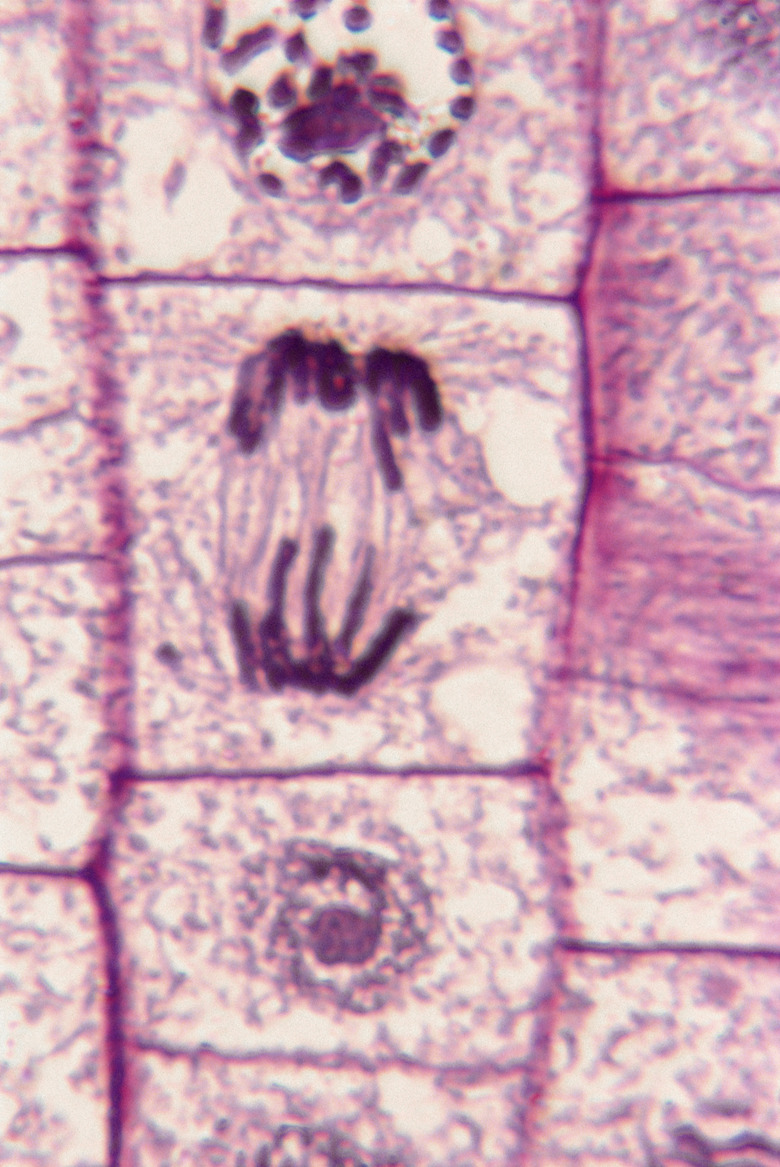Stage In Which The Nucleus & Nucleolus Are Reformed
When cells of advanced organisms divide to form two identical daughter cells, the new cells must each have a nucleus and a nucleolus. During cell division, the nucleus has to dissolve because the duplicated chromosomes it contains have to be free to migrate to opposite ends of the cell.
Once the chromosome migration is complete, two new nuclei can form along with new nucleoli. The dividing membrane creating the two new cells forms and each new cell receives one of the new nuclei with its nucleolus.
The Cell Prepares for Division During the Interphase
The Cell Prepares for Division During the Interphase
After a successful cell division, the resulting cells enter the _interphase_ and grow while carrying out functions such as movement for muscle cells, secreting hormones for glands or storing information for brain cells. If the organism is still growing or if cells are injured, these cells may divide again.
If another cell division is triggered, the cell moves into the S-stage of the interphase and starts duplicating its chromosomes. At the end of the S-stage, the cell verifies that it is ready to divide. It checks to make sure all chromosomes are correctly copied, enough cytoplasm and other cell substances are present to form two new cells and the enzymes required for cell division have been synthesized. If everything checks out, the cell enters _mitosis_.
Mitosis Is Carried Out in Four Main Stages
Mitosis Is Carried Out in Four Main Stages
The main purpose of mitosis is to ensure that each daughter cell receives a complete and identical copy of the genetic code. As a result, the stages are defined in terms of the action respecting the chromosomes.
The four stages are the following:
1. Prophase: The spindle that draws the chromosomes to opposite ends of the cell is formed. 2. Metaphase: The spindle lines up the duplicate chromosomes in the center of the cell. 3. Anaphase: The spindle separates the two copies of the chromosomes and draws the copies to opposite ends of the cell. 4. Telophase: A new cell wall forms, creating two new identical daughter cells, each with a nucleus and a nucleolus.
The spindle fibers in mitosis, anchored at opposite ends of the cell by two _centrosomes,_ are the most important structure for separating the two chromosome copies into the new cells.
As the spindle forms at the beginning of mitosis, the nucleus dissolves. At the end of mitosis, the spindle disappears and the nucleus reforms.
The Nuclear Membrane Disappears at the Beginning of Mitosis
The Nuclear Membrane Disappears at the Beginning of Mitosis
A cell is committed to proceeding with division once it leaves the S-stage of the interphase and passes the checkpoint where chromosome integrity is verified. The nuclear envelope breaks down and the nucleolus disappears. These changes are necessary for the formation of the spindle to take place.
The nuclear membrane exists to give the cell DNA and its chromosomes extra protection against damage. During mitosis, the chromosomes don't have this protection and are vulnerable. To limit any damage, the cell proceeds with mitosis as fast as possible.
Most of the cell's lifespan is spent in interphase and the stages without a nucleus are short and infrequent for most cells.
The Nucleus and Nucleolus Reform at the End of Mitosis
The Nucleus and Nucleolus Reform at the End of Mitosis
After the nuclear membrane disappears at the beginning of mitosis, the substances that made up the membrane and the nucleolus remain in the cell. During the final mitosis stage, the telophase, the chromosomes have been separated and the cell grows a new dividing wall.
At this point, the two ends of the cell that will become the new daughter cells each form a new nucleus and a nucleolus.
The substances remaining from the previous dissolution of the nuclear membrane are combined with new material to form the two new nuclear membranes around the separated chromosomes. At the same time as the new dividing cell wall forms to create the two new daughter cells, the two new nuclei and their nucleoli finish forming.
The new cells enter the interphase as identical copies of the original cell.
Cite This Article
MLA
Markgraf, Bert. "Stage In Which The Nucleus & Nucleolus Are Reformed" sciencing.com, https://www.sciencing.com/stage-nucleus-nucleolus-reformed-23030/. 17 June 2019.
APA
Markgraf, Bert. (2019, June 17). Stage In Which The Nucleus & Nucleolus Are Reformed. sciencing.com. Retrieved from https://www.sciencing.com/stage-nucleus-nucleolus-reformed-23030/
Chicago
Markgraf, Bert. Stage In Which The Nucleus & Nucleolus Are Reformed last modified March 24, 2022. https://www.sciencing.com/stage-nucleus-nucleolus-reformed-23030/
